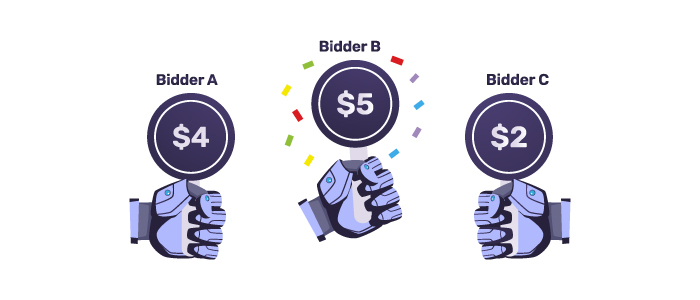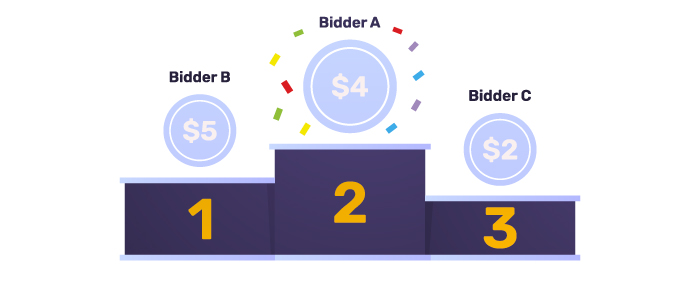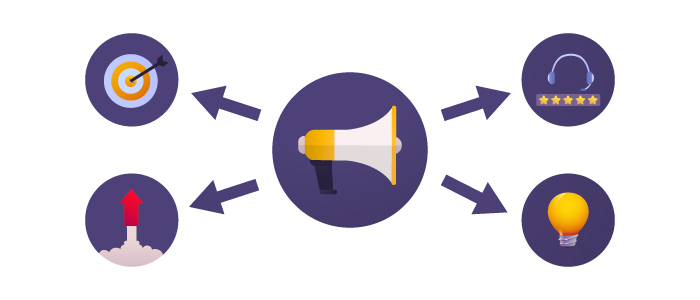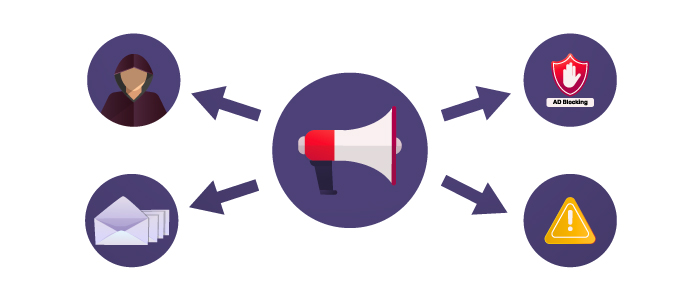First-Price vs. Second-Price Auction Explained with Ease
What do you know about auctions and how they work in programmatic advertising? Why are they important? Well, if you’re not sure of the exact answer, that’s perfectly fine. Nearly half of buyers and sellers don’t understand the differences. Thus let’s find out more about the first-price vs. second-price auction explained.
If you’ve ever bought something on eBay, you’re familiar with the second-price auction (even if you don’t know exactly, you’ve dealt with it unintentionally). For years, programmatic ad buying used this method, but recently, many publishers have switched to a first-price auction model.
Do you know why? In this article, we will explain why and cover everything you must know about first vs second-price auctions.
Table of Contents
Key Terms in This Article
- First-Price Auction – You pay the exact amount you bid if you win the auction.
- Second-Price Auction – If you win, you pay one cent more than the second-highest bid.
- Bid Shading – A tactic of adjusting your bid downward based on past trends and anticipated market value to win without overspending.
- Clearing Price – The amount of the winning bid.
- Reduction – The difference between the highest bid and the final amount paid in a second-price auction.
- Soft Floor Price – A flexible minimum bid level; bids below this amount might still be accepted but with lower priority.
- Hard Floor Price – A strict minimum bid level; bids below this amount are automatically disqualified.
What is a First-Price Auction in Programmatic Advertising?
In programmatic advertising, a first-price auction is a type of auction/bidding model in which the highest bidder wins the ad impression and pays the amount they bid.
In this type of auction, both advertisers and publishers gain visibility into the actual cost of the impression and the fees taken by SSPs or Ad Exchanges, providing a high level of transparency.
First-price auctions generally benefit publishers more than second-price auctions. According to a Digiday survey, 78% of publishers reported that switching from second-price to first-price auctions has helped them maximize their ad revenues.
How Does First-Price Auction Work?

Header bidding has further influenced the dynamics of programmatic advertising by allowing publishers to offer their inventory to multiple demand sources simultaneously before making a final decision. Thus, the highest bidder wins and pays the exact amount they bid for the ad impression, providing transparency for advertisers and publishers.
To illustrate, consider an auction with three bidders:
- Bidder A offers $3.
- Bidder B offers $5.
- Bidder C offers $4.
Because the first-price auction model is used, Bidder B, who has the highest bid, wins the auction and pays $5, the exact amount he bid.
What is Bid Shading?
Related to first-price auctions, advertisers usually use bid shading.
Bid shading is a tactic advertisers use to secure impressions at the lowest possible price (pay less than their maximum bid while still winning the ad impression). By analyzing the highest potential bid, bid shading algorithms attempt to predict the market value of a given impression, often reducing the price advertisers pay. This practice can significantly impact publishers, potentially reducing their ad revenue by up to 20%.
One effective strategy for publishers is setting a floor price to counter bid shading. In traditional auction models, floor prices directly influence the clearing price—the final price paid for an impression.
However, in first-price auctions, floor prices do not affect the clearing price in the same way. Instead, the transition to first-price auctions necessitates a reassessment of how publishers use floor prices to safeguard their inventory.
In response to these challenges, adtech companies introduced some rules to help publishers. For example, Google introduced unified pricing rules designed to help publishers optimize their floor prices.
To effectively counter bid shading and maximize revenue, publishers should focus on accurately valuing their inventory and adjusting prices for different inventory segments accordingly. This approach ensures that they can better protect their ad space and maintain fair pricing.
What is a Second-Price Auction in Programmatic Advertising?
In programmatic advertising, a second-price auction is a digital buying model where the highest bidder wins the ad impression but pays only $0.01 more than the second-highest bid. This encourages advertisers to bid for the maximum amount they are willing to pay, as they often pay less than their bid.
In this type of auction, advertisers benefit from potentially lower costs since they do not pay their full bid amount, which can lead to more efficient use of their advertising budget. However, compared to first-price auctions, transparency regarding the actual cost of the impression and fees taken by SSPs or Ad Exchanges can be less clear.
Second-price auctions generally favor advertisers because they often pay less than their maximum bid, that’s why many advertisers prefer second-price auctions: for the cost-saving potential. Of course, this model can result in lower ad revenue for publishers.
How Does Second-Price Auction Work?

In a second-price auction, the highest bidder wins the ad impression but pays only $0.01 more than the second-highest bid.
Let’s look at a second-price auction example:
- Bidder A offers $3.
- Bidder B offers $5.
- Bidder C offers $4.
As you can see, Bidder B once again placed the highest bid and won the auction. Bidder B will pay the publisher or ad exchange $0.01 more than the second-highest bid, which was placed by Bidder C at $4.00, resulting in a final payment of $4.01. The price reduction for the bid is the difference between Bidder B’s initial bid amount and the final price per 1000 impressions.
First-Price vs. Second-Price Auction: Top Differences
The difference between both auction models is straightforward. In both cases, the brand with the highest bid emerges as the winner. However, the crucial disparity lies in the pricing mechanism.
In a first-price auction, the winning brand pays the exact amount it bids, determining the transaction price directly.
Conversely, in a second-price auction, the winning brand pays slightly more than the second-highest bid, adding just one cent to secure the victory.
This difference in payment mechanisms influences market dynamics, with first-price auctions potentially yielding higher seller revenue due to potentially inflated bids, whereas second-price auctions often promote efficiency and fairer prices by encouraging bidders to bid their true valuation.
Why the Shift from Second to First-Price Auctions?
The move from second to first-price auctions is driven by a need for more transparency in online ad bidding.
Initially, second-price auctions were used to protect advertisers, ensuring they only paid a bit more than the second-highest bid. However, how different exchanges handled these auctions led to confusion and a lack of clarity.
To maximize their earnings, publishers started using tactics like setting minimum prices (soft and hard floors) or adding extra fees. These methods often increased the final cost beyond what advertisers expected, making second-price auctions more like first-price auctions.
Because of these practices, the benefits of second-price auctions were lost, prompting the industry to shift towards first-price auctions. This change aims to make bidding more straightforward and fairer, where the highest bid wins and is paid as a bid.
First-Price vs. Second-Price Auction: Benefits

From the Publisher’s (Seller’s) Point of View
First-Price Auction Benefits
- Higher Revenue Potential – Publishers receive the full amount of the winning bid, which can be inflated in a first-price auction due to bidder competition. This can lead to higher overall revenue for the publisher.
- Simpler System – The mechanics of a first-price auction are easier to understand and manage. Publishers can see exactly how much each bidder is willing to pay.
- Transparency – First-price auctions reveal the true value bidders place on the item or ad space, allowing publishers to assess market demand more accurately.
Second-Price Auction Benefits
- Increased Competition – Second-price auctions can attract more bidders who might be hesitant to participate in a first-price auction due to fear of overpaying. This can lead to a wider range of bids and potentially higher winning bids.
- Reduced Risk of Manipulation – Since bidders don’t pay their full bid amount, there’s less incentive for them to submit artificially high bids to secure the win. This can create a more level playing field for all participants.
From the Advertiser’s (Buyer’s) Point of View
First-Price Auction Benefits
- Clear Pricing – Advertisers know exactly how much they will pay if they win the auction. This allows for better budget control and campaign planning.
- Potential for High-Value Inventory – First-price auctions might offer access to premium ad inventory that might not be available in a second-price auction due to lower bids.
Second-Price Auction Benefits
- Potentially Lower Costs – Advertisers might win the auction by paying only slightly more than the second-highest bid, which can lead to cost savings compared to a first-price auction.
- Encourages Truthful Bidding – Knowing they won’t pay their full bid amount, advertisers are incentivized to bid more accurately, reflecting their true valuation of the item or ad space.
First-Price vs. Second-Price Auction: Limits

From the Publisher’s (Seller’s) Point of View
First-Price Auction Limitations
- The Bidding War Trap – While competition can drive up revenue, first-price auctions can lead to situations where bidders significantly inflate their bids to win. This can create an unsustainable pricing bubble and make it difficult to predict future auction outcomes.
- Bidder Discouragement – Advertisers who consistently lose auctions due to inflated bids might become discouraged and stop participating altogether. This can reduce competition and ultimately lower revenue in the long run.
- Limited Strategic Bidding – Since the winning bid directly determines the price paid, there’s less room for strategic bidding in a first-price auction. This can make it challenging to optimize your pricing strategy for different types of inventories.
Second-Price Auction Limitations
- Lower Overall Revenue – Second-price auctions guarantee that you won’t capture the full value of the winning bidder’s initial bid. This can lead to lower overall revenue compared to a first-price auction, especially if there’s a significant gap between the highest and second-highest bids.
- Potential for Collusion – In rare cases, there’s a slight possibility that bidders might collude and agree on a low second-highest bid, allowing the winner to acquire the item at a much lower price.
- Less Transparency – Second-price auctions don’t reveal the true value of the winning bidder’s initial bid. This can make it more difficult to gauge market demand and optimize your pricing strategy over time.
From the Advertiser’s (Buyer’s) Point of View
First-Price Auction Limitations
- The Bidding Blind Spot – First-price auctions can be like playing poker with all your cards showing. You know what your competitors are bidding on, potentially leading to bidding wars and inflated costs that might exceed the true value of the ad space.
- Overspending Risk – The pressure to outbid competitors can lead to impulsive bidding decisions. You might end up paying more than you planned or budgeted for the ad space.
- Limited Strategic Options – Since your bid directly determines the price you pay, there’s less room for strategic bidding tactics. Optimizing your bids for different audiences or placements within the auction can be challenging.
Second-Price Auction Limitations
- The “Almost Winning” Frustration – Second-price auctions can be a source of constant near misses. You might consistently be the second-highest bidder but only win occasionally. This can be frustrating and make it difficult to predict campaign performance and budget allocation.
- Less Control Over Costs – While you can set a maximum bid, you ultimately don’t control the final price in a second-price auction. The price can fluctuate depending on the competition, potentially exceeding your initial expectations.
- Limited Transparency – Second-price auctions don’t reveal the full extent of competition or the winning bidder’s initial valuation. This lack of transparency can make it difficult to refine your bidding strategy for future campaigns.
Final Thoughts
As the digital world aims for clearer rules and a friendlier space for sellers and brands alike, a switch to a different auction style might occur down the road (if it’s not already).
Brands are sure to run into a bunch of hurdles as these changes come about, so it’s smart to get ready in advance. Being prepared early on can really pay off. Take, for example, teaming up with a smart partner who knows the ins and outs of both auction types. With their help, you can navigate the bidding process smoothly.
Armed with this insight, you can make smart choices and take advantage of first-price and second-price auctions. By keeping your eyes peeled and staying flexible, you’ll be all set to thrive in the ever-shifting digital market.